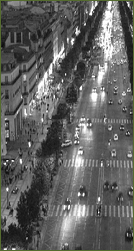|
In 1724, the Tuileries garden axis and the avenue were connected
and extended, leading beyond the Place de l'Etoile, where open parkland flanked it, but it
was soon filled in with trees formally planted in straight rank.
To the east the unloved and neglected "Vieux Louvre" was still hemmed in by
buildings and was not part of the axis.
In a map of 1724, the Grande Avenue des Champs-Elysees stretches West from a newly-cleared
Place du Pont Tournant, now known as the Place de la Concorde.
By the late 1700s, the Champs-Elysees had
become a fashionable avenue and the trees on either side had thickened enough to be given
formal rectangular glades, known as cabinets de verdure. The gardens of houses built along
the Faubourg St-Honore backed onto the formal bosquets, with the grandest of them all
being the ?lysees Palace.
A semi-circle of house fronts now defined the north side of the Rond Point.
Queen Marie Antoinette drove with her friends and took music lessons at the Grand Hotel de
Crillon on the Place Louis XV. The avenue from the Rond Point to the Etoile was
built up during the Empire.
In 1828, the Avenue des Champs-Elysees became city property, and footpaths, fountains, and
gas lighting were added.
Over the years, the avenue has undergone numerous transitions, most recently in 1994, when
the sidewalks were widened.
Because of its size and proximity to several Paris landmarks such as the Arc de Triomphe, the Champs-Elysees has been made
the site of several famous military parades, the most famous of which were the march of
German troops celebrating the Fall of France on 14 June 1940 and the subsequent entrance
of free French and American forces into the city after its liberation on 25 August 1944.
On Bastille Day, every year the largest military parade in Europe passes down the
Champs-?lysees, reviewed by the President of the Republic.
Each year from the end of November to end of December, the 'Champs-Elysees' Committee
contribute to the lighting of the Champs-Elysees for the holiday season.
The Champs-Elysees is also the traditional end of the last stage of the Tour de France.
Huge and spontaneous gatherings occasionally take place on the Champs-Elysees in
celebration of popular events, such as New Year's Eve, or when France won the 1998 FIFA
World Cup at the Stade de France.
|
|


